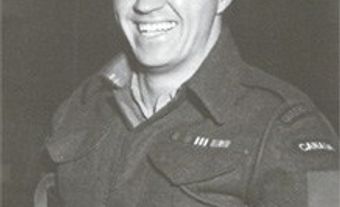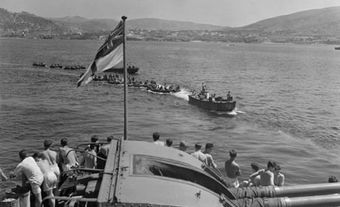This article was originally published in Maclean's Magazine on October 20, 2003
Canadian Troops to Stay in Afghanistan
Their widows wept. A bagpiper played an old, sad song. The faces of comrades were ashen. Memorial services for fallen soldiers are, of course, painfully unique to the families and friends of the dead; but what they offer the nation is familiar ritual, perhaps a feeling of closure. This time, though, the sombre images from a hockey arena in Pembroke, Ont., where Cpl. Robbie Beerenfenger and Sgt. Rob Short were mourned, could not carry the solace of finality. Instead, the news from Afghanistan, where they were killed the previous week by a LAND MINE, reminded anyone paying attention that routine bloodshed in that unfortunate country is far from at an end. And the latest developments on NATO's Afghanistan strategy suggest Canada's involvement there may also stretch on.
A flare-up in fighting between warlords in the north of the country slaughtered dozens, and the ceasefire that followed looked uncertain. Taliban fighters are a resurgent reality, and the deadly drug trade out of the poppy-growing valleys is booming again. Surveying this mess, NATO defence ministers met in Colorado Springs, Colo., to discuss sending their International Security Assistance Force, which has been limited to patrolling the relative calm in and around the capital, Kabul, further out to try to establish security in much more lawless quarters.
Exactly what role Canadians might play in that dangerous expanded mission for ISAF was not certain. For now, Canada is a big factor, accounting for 1,900 of the force's 5,500 troops. The Canadian contingent is slated to be in Afghanistan until next summer. After that, it was assumed that Ottawa would not be able to contribute much more, given the overstretched state of the forces. But following the NATO meeting in Colorado Springs, Defence Minister John McCallum suggested extending the stay, although not at the current robust level.
A key new factor is NATO's plan to substantially shrink its PEACEKEEPING presence in Bosnia. Canada has 1,200 troops there; pulling many or all of them out of the Balkan assignment might allow the armed forces to stay on in Afghanistan. Defence officials were considering perhaps 200 troops for what is being called a "provincial reconstruction team," which would combine soldiers with civilian experts to work on rebuilding schools, bridges and other projects.
The NATO ministers left their meeting talking with new determination. Yet the international community does not seem to have come to grips with the scale of the challenge in Afghanistan in the two years since the U.S.-led invasion ousted the Taliban government. (About 7,000 Canadians took part, and four were lost in a notorious friendly fire bombing by a U.S. jet.) Getting rid of the Taliban was an essential post-Sept. 11 goal: the regime harboured al-Qaeda terrorists. Yet the promised follow-up to that initial victory has taken the lustre off a good start. The aid group CARE estimates that at least US$20 billion is needed in the next four years to begin rebuilding the country. Only about one-quarter of that has been pledged.
Competing with Iraq for attention is a major problem. Washington's latest plans suggest Kabul's needs have been relegated to very much a second-tier priority. Of the US$87 billion that President George W. Bush has asked Congress to approve for military and rebuilding costs in Iraq and Afghanistan, just US$800 million is earmarked for Afghan reconstruction. "There is a large disconnect," says Asif Rahimi, an Afghan working for CARE Canada in Ottawa. "The world community thinks you can do a cheap job in Afghanistan and be finished with the business." With the transitional government of President Hamid Karzai aiming to finalize a new constitution late this year and hold elections in 2004, more aid is needed - with military support to ensure it can be delivered.
Karzai is battling not only for funds, but against the Taliban and others who are willing to kill aid workers to stop the flow of assistance. "If the roads are getting repaired, if the schools are reopening, that means the process is working and people are going to buy into it," Rahimi says. Because of that, he adds, Karzai's opponents "are blocking the reconstruction." CARE reports that armed attacks against assistance workers in Afghanistan occur on average once every two days.
For Canada, Afghanistan has emerged as a top foreign-policy preoccupation. Along with troops, Ottawa has pledged $250 million in aid - the largest single-country commitment ever by the Canadian International Development Agency. But just as the extent of Canadian peacekeeping after next summer is unclear, longer-term assistance remains in doubt. Afghanistan's urgent need seems at odds with CIDA's recent shift to concentrating on a select group of countries that have shown a capacity to use aid effectively. That more focused policy made a lot of sense to a lot of people. But how does Afghanistan, which has no such track record, fit with the strategy? Afghans can only hope that Canada, and other rich nations, don't soon grow weary of their enormous problems and turn away.
Maclean's October 20, 2003

 Share on Facebook
Share on Facebook Share on X
Share on X Share by Email
Share by Email Share on Google Classroom
Share on Google Classroom


